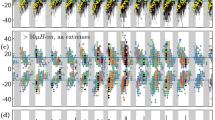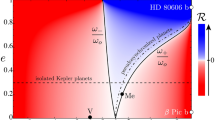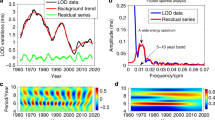Abstract
SUNSPOTS have long been used as tracers to determine the rotation rate of the Sun. Scheiner1 noted 250 years ago that low-latitude sunspots rotate more rapidly than those at high latitude (‘differential rotation’). In a recent review, Howard2 stressed the limitations of the sunspot technique for determining rotation rate and differential rotation, as long-lived spots may have substantial individual motions, random and systematic, in both longitude and latitude. For example, leading and following spots of a sunspot group diverge early in the group's lifetime3; rotation rates for isolated (‘unipolar’) spots and groups differ, with group rates depending on the shape of the group4. Another problem in using sunspots is the Wilson effect, a surface depression of the spot causing errors in longitude estimates away from the central meridian. Despite these difficulties, spots have been used previously to establish that there is no secular variation in rotation rate and differential rotation, nor any variations with phase of the solar cycle5, the only possible exception being during long-term disruptions in the solar activity cycle mechanism6. We present here evidence to suggest that the first of these conclusions is incorrect, and that differential rotation does depend on the amplitude of the solar cycle, at least for unipolar spots.
This is a preview of subscription content, access via your institution
Access options
Subscribe to this journal
Receive 51 print issues and online access
$199.00 per year
only $3.90 per issue
Buy this article
- Purchase on Springer Link
- Instant access to full article PDF
Prices may be subject to local taxes which are calculated during checkout
Similar content being viewed by others
References
Scheiner, C. Rosa ursina sive sol (Andreas Phaeus, Braccuabi, Italy, 1630).
Howard, R. Rev. Geophys Space Phys. 16, 721 (1978).
Mon Not. R. astr. Soc. 85, 553 (1925).
Ward, F. Astrophys. J. 145, 416 (1966).
Newton, H. W. & Nunn, M. L. Mon. Not. R. astr. Soc. 111, 413 (1951).
Eddy, J. A., Gilman, P. A. & Trotter, D. E. Solar Phys. 46, 3 (1976).
Mon. Not. R. astr. Soc. 85, 548 (1925).
Newton, H. W. Mon. Not. R. astr. Soc. 95, 60 (1935).
Carrington, R. C. Observations of the Spots on the Sun (Williams and Norgate, London, 1863).
Gillman, P. A. in Basic Mechanisms of Solar Activity, IAU Symp 71 (eds Bumba, V. & Kleczek, J.), 207 (Reidel, Dordrecht, 1976).
Wöhl, H. Astr. Astrophys. 62, 165 (1978).
Author information
Authors and Affiliations
Rights and permissions
About this article
Cite this article
CLARK, D., YALLOP, B., RICHARD, S. et al. Differential solar rotation depends on solar activity. Nature 280, 299–300 (1979). https://doi.org/10.1038/280299a0
Received:
Accepted:
Issue Date:
DOI: https://doi.org/10.1038/280299a0
This article is cited by
-
Richard Christopher Carrington: Briefly Among the Great Scientists of His Time
Solar Physics (2012)
-
Periodicities in the solar differential rotation, surface magnetic field and planetary configurations
Solar Physics (1995)
-
The secular modulation of solar rotation from 1943 to 1992 and its time-delayed correlation with the 55-year grand cycle of the 11-year solar cycle
Solar Physics (1993)
-
Solar differential rotation derived from sunspot observations
Solar Physics (1990)
-
Application of the Markov chain approximation to the sunspot observations
Earth, Moon and Planets (1988)
Comments
By submitting a comment you agree to abide by our Terms and Community Guidelines. If you find something abusive or that does not comply with our terms or guidelines please flag it as inappropriate.



